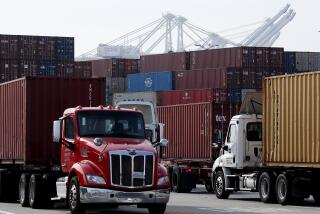Curbing Big Rigs : Drive Seeks Rush-Hour Ban on Ventura Freeway
- Share via
They should call it the “Battle of the Ban.”
On one side politicians are bent on banning trucks from clogged freeways at rush hours; on the other truckers hope to fend off mandatory bans by reducing big-rig traffic on their own.
The first skirmish in the conflict is being fought on the Ventura Freeway, where a voluntary truck ban is already credited with a 33% decrease in large-truck traffic during morning and evening commutes.
The Ventura Freeway is not only the site of the showdown, it is serving as the example both sides like to cite in support of their positions. Public officials calling for a ban point to the congested thoroughfare as a sign that restrictions are long overdue. The trucking industry, on the other hand, says the success of the voluntary program, prompted by a four-year renovation of the freeway, shows that such prohibitions are unnecessary.
Karen Rasmussen, director of industry affairs for the California Trucking Assn., said the one-third decrease in large-truck traffic from 6 to 9 a.m. and from 3 to 6 p.m. recorded in a Caltrans study, shows that self-regulation works. “I think the Ventura is a good example,” she said.
The same study, based on two-day traffic counts in August and March, also showed a 15% drop in the number of commercial trucks of all sizes traveling during rush hours. Steven Koff, president of the Southern California Grocers Assn., predicted that the voluntary program would set a precedent for other cities and businesses. “We could take the results of this and show other areas that we can be successful,” said Koff, who has urged the association’s 1,200 member companies to cooperate with truckers on the program.
But Los Angeles Councilmen Zev Yaroslavsky and Michael Woo, although praising the trucking lobby’s voluntary efforts, vowed last week to continue to push for a mandatory ban on trucks during rush hours.
“I think it’s inevitable,” Yaroslavsky said.
Despite the blunt talk, things have yet to turn acrimonious. Truckers replied indirectly or with understatement when asked about the industry’s uncomfortable role in the spotlight.
“Let’s face it, trucks are big,” one trucking company official said.
Yaroslavsky said a truck ban is overdue because big rigs, despite their small numbers, can tie up a freeway for two or three hours if they jackknife or spill a load of cargo such as watermelons or gravel.
According to Caltrans, big five-axle trucks account for only 2% to 3% of the traffic on the Ventura Freeway in the West San Fernando Valley during rush hours. A Caltrans study said trucks were involved in about 8% of all rush-hour injury accidents there.
At Yaroslavsky’s urging, the council asked the state to consider mandatory truck restrictions on Jan. 29, but Caltrans has resisted the request and supported a voluntary ban. At a news conference last week, Caltrans officials joined Yaroslavsky in unveiling orange freeway signs that would urge truckers: “Reschedule to Avoid Peak Hours.”
But from the truckers’ point of view, the signs would be better placed at businesses and shopping malls, not freeways. “It’s not a trucking issue, it’s a shipping and receiving issue,” Rasmussen said.
Mike Williams, operations manager of Hadley Auto Transport in La Mirada, agreed, saying his firm’s switch to nighttime deliveries 18 months ago succeeded only because his clients cooperated. Hadley delivers automobiles to dealerships throughout Southern California.
“There were some we had to sell the idea to,” Williams said.
Magnum Freight Lines of Montebello faced similar opposition but has also stepped up its nighttime deliveries to grocery stores, said Dan Reynolds, company president.
Although his company has had some success in scheduling during off-hours, Reynolds said switching delivery times is difficult for some businesses, impossible for others. Some companies must add extra shifts and haggle with unions, he said, and others must obediently follow the schedules of the docks.
Still other receivers must abide by local noise ordinances prohibiting deliveries near residential neighborhoods in the early morning or late at night. As part of the voluntary ban in the Ventura Freeway program, the Los Angeles City Council unanimously lifted such restrictions in some parts of the Valley in March.
Rasmussen said it is impossible to know just how many truckers are voluntarily staying off the Ventura Freeway and how many are delivering after dark, regardless of the freeway they take. But the Sacramento-based trucking lobby hopes to encourage more nighttime deliveries through a summer campaign aimed at shippers and receivers.
Rasmussen said the association is preparing information packets on the advantages of off-hour deliveries that its 2,500 member companies can present to their clients. The association has already sponsored a one-day conference on alternatives to banning trucks, which attracted about 300 truckers, shippers and retailers to Anaheim on April 15, she said.
Yaroslavsky agreed that truckers cannot act alone, but said truck traffic must be regulated because it is easier to police the big rigs than hundreds of stores and firms. “They are a major link in the chain,” he said. He added that, if truckers are regulated, “the clients will follow.”
More to Read
Sign up for Essential California
The most important California stories and recommendations in your inbox every morning.
You may occasionally receive promotional content from the Los Angeles Times.













